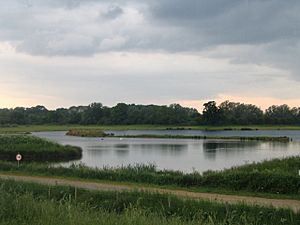Deeping Lakes Nature Reserve facts for kids
Quick facts for kids Deeping Lakes Nature Reserve |
|
|---|---|
 |
|
| Lua error in Module:Location_map at line 420: attempt to index field 'wikibase' (a nil value). | |
| Type | Local Nature Reserve |
| Location | Deeping St James, Lincolnshire, England |
| OS grid | TF187083 |
| Area | 71 hectares (180 acres) |
| Managed by | Lincolnshire Wildlife Trust |
Deeping Lakes Nature Reserve, also known as Deeping Gravel Pits, is a special place for nature. It covers more than 71 hectares (about 175 acres) in Lincolnshire, England. This reserve is south-east of Deeping St James. It includes part of the Deeping Gravel Pits SSSI. This means it's a very important area for its wildlife and geology.
Contents
Discover Deeping Lakes Nature Reserve
This nature reserve is made up of several lakes. These lakes were once places where gravel was dug out of the ground. Now, they are filled with water and have become a wonderful home for many different plants and animals. It's a great example of how old industrial sites can turn into beautiful natural spaces.
History of Deeping Lakes
The largest lake at the reserve was dug out a long time ago, in the 1800s. Over time, it slowly changed and became a natural lake. The two smaller lakes are much newer, created in the 1990s.
A long time ago, in 1848, this area was used as a place to make bricks. Then, in 1870, people started digging for gravel. The biggest lake and another one called 'the Mere' were dug to get stone. This stone was used to build the Great Northern Railway.
The Mere was once owned by Richard Thompson. He made it a lovely place by planting trees and adding fish. It even became a popular spot for tourists! In 1968, both the large lake and The Mere were officially named a Site of Special Scientific Interest (SSSI). This protects them because they are so important for nature.
Lincolnshire Wildlife Trust's Role
The Lincolnshire Wildlife Trust bought the main lake in 2003. They now look after the entire reserve. They also manage the smaller lakes, which they lease for a long time.
In 2015, one of the lakes was changed to make it better for wildlife. They leveled parts of it and broke up three old islands. These islands were then raised to create 27 smaller islands. These new islands provide more safe places for birds to nest and rest.
Sometimes, the reserve faces challenges. In 2019, some oil was illegally dumped into the River Welland. This affected many wild birds at the reserve. The Lincolnshire Wildlife Trust worked with the Environment Agency and the RSPCA. They helped clean up the oil and rescued 25 mute swans that were covered in it. The site also had problems with illegal dumping of rubbish in September 2019.
Even during the COVID-19 Pandemic, the reserve and its car park stayed open. This allowed people to enjoy nature safely.
Amazing Wildlife at Deeping Lakes
Deeping Lakes is famous for its many different kinds of wildfowl and waterbirds. You can also find rare plants here, like the Dactylorhiza incarnata, which is a type of early marsh-orchid.
In the 1950s, the Wildfowl & Wetlands Trust used the Mere to set up a special trap for bird ringing. Bird ringing helps scientists learn about bird movements and how long they live. Between 1964 and 1984, over 11,000 ducks were ringed on an island here. One common pochard duck, ringed in 1966, was found in Russia in 1968!
In 1990, people counted 103 heron nests at the reserve. However, the number of heron nests has gone down over the years. This might be because more cormorants are now breeding at the site.
By 2016, people started seeing otters regularly at Deeping Lakes. Otters are playful animals that love to live near water. Seeing them here shows that the reserve is a healthy place for wildlife.
Images for kids


